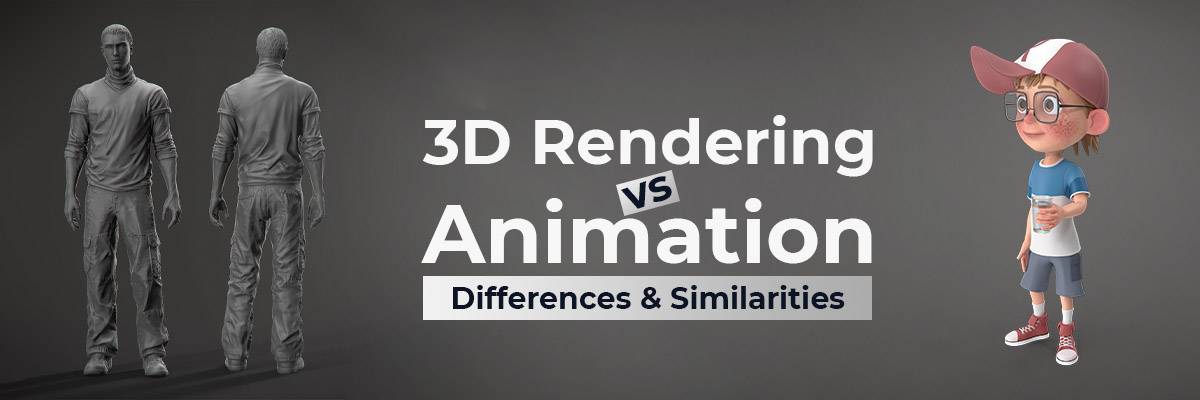You might have heard of the term rendering in 3D Animation once in your life, and if you are a 3D modeler, then these are the words you hear and use daily. But many of us think both are the same and might have used the terms interchangeably.
But, honestly, no matter how similar these two processes look, they still have a prominent difference which we will discuss in this article. But before we jump onto this topic, it is essential to get a basic idea of both the terminologies and what still 3D Rendering and 3D Animation mean.
What is 3D Rendering?
3d Rendering is a process using which life-like visualization is created of anything, be it an object, an environment, or a building, even before it is built.
The technology has made it possible to create renders that look like taking a glance through a camera. For example, in a 3D rendered image, every minute detail of a visual is created using various meshes. However, the visuals created in a still 3D rendering or Animation are still static and look like a camera is moving and showcasing the objects from different angles.
Now let us understand what 3D animation is as a process.
What is 3D Animation?
Regarding 3D Animation, a three-dimensional angle is given to 2D digital objects. This means this process can move the objects to various dimensions showcasing various positions, rotations, and more.
3D animation is tied up with providing a real to life experience to the viewers, and it is made possible through the movement of objects. In 3D Animation, objects come to life, as they all have individual movements and can be seen from various angles giving an in-depth detail of the design and usability.
Now that we know both terminologies, it is time to understand their fundamental differences.

Still 3D Rendering vs 3D Animation- Difference
Here we are discussing the significant differences between still and animated 3D renders. But, first, let’s look at how both are ‘same but different.’
-
The Movement
Still 3D Rendering
In this process, the movement we see or experience is only of the camera, and it is the only way we can see the details of the object or design created.
3D Animation
In render comparison, the process of 3D Animation always has the upper hand as in this, the whole object moves to show every side of it and gives the viewers a real to life experience.
-
The Position
Still 3D Rendering
When it comes to the positioning of the objects, the visuals we see through this process are only of a moving camera while the object remains still. This means we can only see an object in a way the camera allows or in various positions a camera can show.
3D Animation
In this process, the position can be of all types, including rotation, angular, and position change. 3D Animation gives a complete view of an object making it more realistic.
Still 3D Rendering vs 3D Animation- Similarities
Despite being different from each other, both the processes have a lot of similarities, including-
-
Visualization
When it comes to visualization, both still 3D Rendering and Animation are digital visualizations that give real-to-life effects to objects and are very close to virtual reality.
-
Effects
Both processes use the same effects, including the various gradients, drop shadows, and lighting. These features allow the designs to bring out the best in-store and help highlight the essential features and enhance the atmosphere.
One significant effect that makes both the processes similar to each other is Highlighting. It helps in creating 2D images to look like 3D models.
-
The Virtual Reality
Both processes can showcase virtual reality in the designs. It seems like a person is walking in the room virtually. These processes show the objects in detail and give a whole design idea.
Important: Still 3D Rendering & Animation these both processes used in Architectural planning and representation of the living or commercial space even before it is created.
What is 3D Rendering in Animation?
3D rendering technology is the most common technique used in the 3D animation industry. Nothing is possible without 3D Rendering in this modern virtual reality world, from digital magazines to television to online advertisements to the gaming world.
Also, this technique is quite evident in the industries like architecture, product-centric businesses, and others.
By the time this technology has emerged as the most cost-effective option; hence it is quite popular in almost all walks of the industry today.
Use of 3D Rendering in Animation
- To visualize future projects, especially in architecture
- Entertainment purpose and creating 3D movies and OTT shows
- To enhance the quality of their pictures and project presentation
- From conceptualizing to reverse engineering in product manufacturing
- To create and design healthcare products, prosthetic designs & other medical devices, also used for 3D imaging
- For streamlined marketing and branding purposes
Conclusion
With this, we conclude our detailed discussion on still 3D rendering and animation. Both of these digital technologies have their due applications in various areas. And both have their respective similarities and advantages.
Hope you have got a fair understanding of the two concepts and their fundamental differences. Because any aspiring 3D artist must have complete knowledge of the various 3D technologies.
So, if you are an aspiring 3D modeler or professional 3D rendering artist, bookmark this blog. This handy guide will give you a preliminary gist of both of these high-end technologies. Which one to use for what purpose - you can also get this figured out from this blog.
If you need professional assistance in sharing some of your 3D project’s workload, contact an agency with the best experts. These professional agencies offer stellar 3D modeling services and custom 3D rendering solutions.

Social Media Video Editing